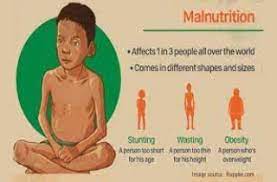30 Jul 2022 Curbing malnutrition in india

- Recently the Ministry of Women and Child Development has set targets to curb malnutrition in India.
Targets set to curb malnutrition:
- Aim to reduce stunting and undernutrition (prevalence of underweight) by 2% per annum in children under 6 years of age.
- Prevention of undernutrition of children of 0 to 6 years of age and to reduce it at the rate of 6 percent i.e. 2% per annum.
- To reduce the prevalence of anemia in children aged 6 to 59 months at the rate of 9% per annum.
- To reduce the prevalence of anemia among adolescent girls, pregnant and lactating mothers in the age group of 15 to 49 years by 9% or 3% per annum.
- Anemia is a condition in which the number of red blood cells or its oxygen-carrying capacity is insufficient to meet the body’s need for blood.
- This is highlighted in the NFHS-5 report which includes detailed information on key segments of the population, such as:
- Health and Family Welfare, Fertility, Family Planning, Infant and Child Mortality, Maternal and Child Health, Nutrition and Anemia, Morbidity and Health Care, Women Empowerment etc.
Findings of NFHS-5:
Data on stunted children:
- Meghalaya has the highest number of stunted children (46.5%), followed by Bihar (42.9%).
- Maharashtra has the highest rate of child wasting/disability among children at 25.6%, followed by Gujarat (25.1%).
- Jharkhand has the highest percentage (26%) of women between the ages of 15 and 49 who have a below normal body mass index (BMI).
Other Conclusions:
- The total fertility rate (TFR), the average number of children per woman, decreased from 2.2 nationally to 2.0 between NFHS -4 and 5.
- The overall Contraceptive Prevalence Rate (CPR) in the country has increased from 54% to 67%.
- Institutional births in India have increased from 79% to 89%.
- As per the report, stunting/dwarfism has come down from 4% to 35.5%, wasting has come down from 21.0% to 19.3% and underweight has come down from 35.8% to 32.1%.
- Women (15-49 years old) with a below normal body mass index (BMI) decreased from 22.9% in NFHS-4 to 18.7% in NFHS-5.
Malnutrition and related initiatives:
- Malnutrition is a condition that develops when the body is deprived of the vitamins, minerals and other nutrients it needs to maintain healthy tissue and organ function.
- Malnutrition occurs in people who are either malnourished or over-nourished.
Initiative:
- POSHAN Abhiyaan: The Government of India has launched the National Nutrition Mission (NNM) or POSHAN Abhiyaan to ensure “Malnutrition Free India” by the year 2022.
- Anemia Mukt Bharat Abhiyan: Launched in the year 2018, the mission aims to reduce the annual rate of anemia by one to three percentage points.
- Pradhan Mantri Matru Vandana Yojana (PMMVY): Rs 6,000 is directly transferred to the bank accounts of pregnant women to get better facilities for delivery.
- Integrated Child Development Services (ICDS) scheme: It was launched in the year 1975 and the objective of this scheme is to provide food, pre-school education, primary health care, immunization, health check-up and other is to provide services.


No Comments